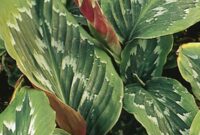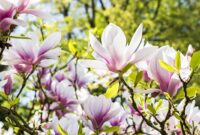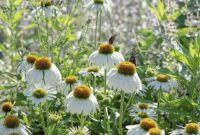I. Getting to the Root of the Issue
A. Introducing the Dilemma: Yellowing Rhododendron Leaves
Rhododendrons, with their stunning blossoms and lush foliage, are cherished additions to gardens and landscapes. However, when those vibrant green leaves start to turn a worrisome shade of yellow, it’s a clear sign that something isn’t quite right.
This dilemma, often encountered by both novice and experienced gardeners, is a common yet perplexing challenge that requires our attention. The sight of yellowing leaves on your rhododendron can be disheartening, but it’s crucial to understand that this visual signal is your plant’s way of communicating its distress.
Leaves serve as messengers, indicating that the rhododendron is facing internal or external issues that need addressing. As a responsible gardener, it’s your role to decipher this message and take appropriate action to restore your plant to its full vitality.
B. Emphasizing the Importance of Swift Troubleshooting
Time is of the essence when dealing with yellowing rhododendron leaves. Addressing the underlying causes promptly can make the difference between nursing your plant back to health and witnessing a decline in its overall well-being.
Yellow leaves not only affect the aesthetic appeal of your rhododendron but also serve as indicators of its overall health. Ignoring the issue or delaying action might lead to more severe problems, potentially even jeopardizing the survival of your cherished plant.
Moreover, taking quick action to diagnose and treat the issue can prevent it from spreading to other plants in your garden. Many of the factors that contribute to yellowing leaves, such as nutrient deficiencies or pests, can have ripple effects if not managed in a timely manner.
By addressing the problem swiftly, you not only save your rhododendron but also protect the health of your entire garden ecosystem. In the following sections, we’ll delve into the various factors that could be causing your rhododendron leaves to turn yellow.
Understanding these causes is the first step toward effective troubleshooting and successful resolution. Remember, every garden is unique, and the specific cause of yellowing leaves may vary. So, let’s embark on this journey of discovery and learning to nurture our rhododendrons back to their vibrant and healthy state.
II. Understanding Rhododendron Plants
A. Exploring the Beauty of Rhododendron Plants
Before delving into the complexities of addressing yellowing leaves, let’s take a moment to appreciate the remarkable nature of rhododendron plants.
These botanical wonders belong to the genus Rhododendron, encompassing a diverse range of species and cultivars that vary in size, shape, and color.
Native to various regions around the world, rhododendrons are renowned for their vibrant and often show-stopping blossoms.
The leaves of rhododendrons are equally captivating, characterized by their glossy, leathery texture and rich green hues.
Depending on the species, they can be broad or lance-shaped, creating a unique visual appeal that complements their colorful blooms.
Rhododendrons thrive in various climates, from temperate to subtropical, making them a popular choice for gardens, landscapes, and even container gardening.
B. Significance of Healthy Foliage for Plant Health and Aesthetics
The foliage of a rhododendron is more than just an ornamental aspect; it plays a vital role in the overall health and aesthetics of the plant.
Leaves are the primary site for photosynthesis, the process by which plants convert sunlight into energy to fuel their growth and development.
Healthy leaves ensure that the plant has an adequate supply of nutrients and energy to thrive.
Vibrant green leaves also contribute to the visual appeal of rhododendron plants. They provide a lush backdrop for the striking blossoms, creating a harmonious balance of color and texture in the garden.
When the leaves start to turn yellow, it’s a clear sign that something within the plant’s internal workings or external environment is amiss.
Addressing the underlying causes of yellowing leaves not only restores the plant’s health but also revitalizes its aesthetic charm.
In the upcoming sections, we’ll dive into the factors that can lead to the yellowing of rhododendron leaves.
By understanding the significance of healthy foliage and the factors that contribute to its decline, you’ll be better equipped to identify the root causes of the issue and take appropriate steps to remedy the situation.
Let’s explore the world of rhododendron care with the goal of nurturing these botanical marvels to their full potential.
III. Common Causes of Yellowing Rhododendron Leaves
Rhododendrons are incredibly sensitive indicators of their environment. When their leaves start to lose their lush green hue and take on a yellow tinge, it’s a clear signal that something in their growing conditions isn’t quite right.
Let’s explore some of the most common culprits behind yellowing rhododendron leaves and delve into how to address each issue effectively.
A. Nutrient Deficiencies: The Whisper of Chlorosis
Yellowing leaves often point to an essential conversation between your rhododendron and its required nutrients. Chlorosis, the condition in which leaves lose their vibrant green color, can occur due to the lack of vital nutrients.
Iron, magnesium, and nitrogen are crucial players in maintaining the lush green foliage your rhododendron deserves.
Iron: A deficiency in iron can lead to interveinal chlorosis, where the tissue between the veins turns yellow while the veins remain green. Adding chelated iron to the soil or using foliar sprays can help address this issue.
Magnesium: A lack of magnesium may cause the older leaves to yellow while the veins remain green. Epsom salt, which is magnesium sulfate, can be added to the soil to replenish this nutrient.
Nitrogen: Inadequate nitrogen levels lead to overall leaf yellowing. Nitrogen is responsible for leaf growth and chlorophyll production. Incorporating balanced fertilizers or organic matter rich in nitrogen can help restore healthy foliage.
B. Soil pH Imbalance: The Hidden Nutrient Key
Soil pH plays a significant role in nutrient availability to your rhododendron. When the pH is too high or too low, certain nutrients become less accessible to the plant, even if they are present in the soil.
For rhododendrons, an optimal pH range of slightly acidic to neutral (around 5.0 to 6.0) is essential.
Acidic Soil: If your soil is too alkaline, it can lead to nutrient deficiencies like iron and manganese, resulting in yellowing leaves. Amending the soil with organic matter or sulfur can help lower pH levels.
Alkaline Soil: In alkaline soil, nutrients like phosphorus, potassium, and calcium may become less available. Adding organic matter and using appropriate soil amendments can help raise pH levels and improve nutrient absorption.
C. Watering Issues: Finding the Right Balance
Water is a precious resource for rhododendrons, and their leaves can reveal when they’re not receiving the appropriate amount.
Inconsistent watering practices, whether it’s too little or too much, can result in yellowing leaves.
Inadequate Watering: Insufficient water supply can stress the plant, leading to leaf wilting and yellowing. Ensuring consistent moisture, especially during dry periods, is essential.
Excessive Watering: Overwatering can lead to waterlogged soil, preventing the roots from accessing oxygen. This can result in yellow leaves and even root rot. Adjusting your watering schedule and improving drainage can alleviate this issue.
D. Poor Drainage: Battling Waterlogged Soil
Poor drainage is a common issue that can lead to various plant problems, including yellowing leaves.
When soil doesn’t drain well, it becomes compacted and retains excess water, suffocating the roots and impeding nutrient uptake.
Risks of Waterlogged Soil: Waterlogged soil can lead to reduced oxygen availability for roots, causing stress and nutrient deficiencies. The lack of aeration can also encourage root rot.
Improving Drainage: To address poor drainage, consider amending the soil with organic matter, creating raised beds or mounds, and ensuring that containers have proper drainage holes.
IV. Environmental Factors Contributing to Yellow Leaves
Rhododendrons, like all living beings, interact closely with their environment. The interplay between the elements—sunlight, temperature, wind, and weather—can significantly influence the health of their leaves.
Let’s delve into these environmental factors and understand how they can contribute to the yellowing of rhododendron leaves.
A. Sunlight and Shade: The Dance of Light and Shadow
1. Sunburn: While rhododendrons love dappled sunlight, excessive exposure to intense sunlight can lead to sunburn. Sunburned leaves often display yellowing, browning, or scorched patches. Providing partial shade or using shading materials can protect your rhododendron from the sun’s harsh rays.
2. Finding the Right Balance: Understanding your rhododendron’s sunlight preferences is key. Too much shade can also cause stress, leading to yellowing leaves due to reduced photosynthesis. Aim for a location with filtered sunlight that mimics their natural woodland habitats.
B. Temperature Extremes: Weathering the Storm
1. Temperature Fluctuations: Rapid shifts in temperature, especially during early spring or late fall, can stress rhododendrons and result in yellowing leaves. Cold snaps after warm periods can damage delicate foliage.
2. Strategies for Protection: When frost or freezing temperatures are predicted, consider covering your rhododendron with frost cloths or blankets overnight. Mulching around the base of the plant can help regulate soil temperature and protect the roots.
C. Wind and Weather: Battling the Elements
1. Impact of Harsh Winds: Strong winds can lead to moisture loss from leaves through transpiration, causing stress and yellowing. Wind can also physically damage leaves, creating entry points for diseases and pests.
2. Creating Wind Barriers: Strategically placing windbreaks, such as fences, hedges, or other plants, can shield your rhododendron from harsh winds. Alternatively, you can create temporary wind barriers using burlap or fabric.
By carefully managing these environmental factors, you can greatly reduce the risk of yellowing leaves and ensure the overall health and beauty of your rhododendron.
Remember that each plant is unique, so it’s important to monitor your specific rhododendron’s response to its surroundings and make adjustments accordingly.
V. Pests and Diseases: Unmasking the Culprits Behind Yellowing Leaves
The battle for vibrant rhododendron leaves extends beyond environmental factors and nutrient imbalances. Pests and diseases are silent invaders that can lead to yellowing leaves and other undesirable symptoms.
Let’s uncover the common culprits and understand how to recognize their presence.
A. Identify Common Pests: Tiny Troublemakers
1. Aphids: These small, soft-bodied insects feed on the sap of leaves, causing them to yellow, curl, and distort. You might also notice sticky honeydew on the leaves.
2. Spider Mites: These minuscule arachnids suck the sap from leaves, causing stippling, yellowing, and webbing. They thrive in dry conditions.
3. Whiteflies: These tiny white insects congregate on the undersides of leaves, sucking sap and causing yellowing, wilting, and leaf drop.
4. Rhododendron Borers: Larvae of these beetles tunnel into stems, disrupting water and nutrient flow. Infested branches can display yellowing leaves and dieback.
B. Recognize Diseases: Unwelcome Intruders
1. Phytophthora Root Rot: This fungal disease can cause yellowing leaves, wilting, and eventual death. It’s often associated with poorly drained soil.
2. Powdery Mildew: A white, powdery substance on leaves can be a sign of powdery mildew, a fungal infection that can cause leaves to yellow and curl.
3. Leaf Spot Diseases: Various fungal and bacterial diseases can cause dark spots on leaves, which may lead to yellowing, defoliation, and overall decline.
4. Rhododendron Wilt: This soil-borne disease can cause yellowing leaves, wilting, and death of branches. It’s often identified by a sudden wilt of a branch or section of the plant.
Recognizing these pests and diseases early is crucial for effective management. Regular inspections of your rhododendron, especially the undersides of leaves, can help you catch problems before they escalate.
Integrated pest management techniques, such as promoting beneficial insects and using horticultural oils, can aid in preventing and managing pest infestations.
For diseases, proper sanitation, improved air circulation, and, in some cases, fungicides might be necessary.
VI. Solutions and Remedies: Nurturing Your Rhododendron Back to Health
Understanding the causes behind yellowing rhododendron leaves is only half the battle. The other half lies in implementing effective solutions and remedies to restore your plant’s vitality and beauty.
Let’s explore practical steps you can take to address each underlying issue.
A. Soil Amendments: Feeding the Roots
1. Amending Soil with Nutrients: If nutrient deficiencies are to blame, enrich the soil with appropriate nutrients. Incorporate well-balanced fertilizers, such as those formulated for acid-loving plants, following package instructions.
2. Suitable Fertilizers and Additives: Opt for fertilizers containing essential elements like iron, magnesium, and nitrogen. Organic options, such as compost or well-rotted manure, can also improve soil fertility.
B. pH Adjustment: Finding the Sweet Spot
1. Raising or Lowering Soil pH: To correct pH imbalances, use lime to raise pH in acidic soil and sulfur or aluminum sulfate to lower pH in alkaline soil. Follow recommended application rates based on soil test results.
2. Regular Soil Testing: Regularly test your soil’s pH to ensure it remains within the optimal range for rhododendron growth. Test kits are readily available and can guide your pH adjustment efforts.
C. Watering Best Practices: Quenching the Thirst
1. Proper Watering Techniques: Water deeply and consistently, ensuring that the soil is moist but not waterlogged. Water in the early morning to minimize fungal growth and water loss due to evaporation.
2. Mulch for Moisture Retention: Apply a layer of organic mulch around the base of your rhododendron. Mulch helps retain soil moisture, regulates temperature, and reduces weed competition.
D. Drainage Improvement: Letting It Flow
1. Enhancing Soil Drainage: If poor drainage is the issue, amend the soil with organic matter to improve its structure. Raised beds or mounds can also help water drain away from the roots.
2. Raised Beds or Mounds: Consider creating raised planting beds or mounds to elevate the root zone above potential waterlogging. These structures allow excess water to drain away more effectively.
E. Protective Measures: Shielding Against the Elements
1. Shielding from Excessive Sun, Wind, and Temperature: Use shading materials, like burlap or shade cloth, to protect your rhododendron from intense sunlight. Windbreaks, such as fences or other plants, can safeguard against harsh winds.
2. Temporary Covers: During temperature extremes, cover your rhododendron with frost cloths or blankets overnight to provide insulation from frost and cold temperatures.
By addressing these solutions and remedies, you’re taking proactive steps to nurse your rhododendron back to health and vibrancy. Remember that patience and consistent care are key; changes won’t occur overnight, but your efforts will be rewarded as you see your rhododendron’s leaves regain their lush green beauty.
VII. Pest and Disease Management: Safeguarding Your Rhododendron’s Health
Pests and diseases can be formidable adversaries, but armed with knowledge and effective management strategies, you can ensure your rhododendron’s resilience against these threats.
Let’s delve into how you can implement strategies to protect your beloved plant from these challenges.
A. Integrated Pest Management (IPM): Balancing Act for Pest Control
1. Understanding IPM: Integrated Pest Management is a holistic approach that combines various strategies to control pests while minimizing harm to beneficial organisms and the environment.
2. Non-Chemical and Chemical Methods: Start with non-chemical methods such as handpicking pests, using water sprays, introducing natural predators, and creating physical barriers. If necessary, consider targeted chemical treatments, always following manufacturer instructions.
B. Disease Prevention and Treatment: Fortifying Defenses
1. Sanitation Practices: Prevention is key when it comes to diseases. Regularly remove fallen leaves, prune affected branches, and maintain proper spacing between plants to improve air circulation and reduce disease spread.
2. Fungicides and Treatments: For specific diseases, such as powdery mildew or leaf spot, fungicides can be used as part of an integrated approach. Follow recommended application rates and timing for best results.
Remember that both pests and diseases thrive in weakened or stressed plants.
By focusing on overall plant health through proper watering, nutrition, and environmental management, you create conditions that naturally deter these problems.


